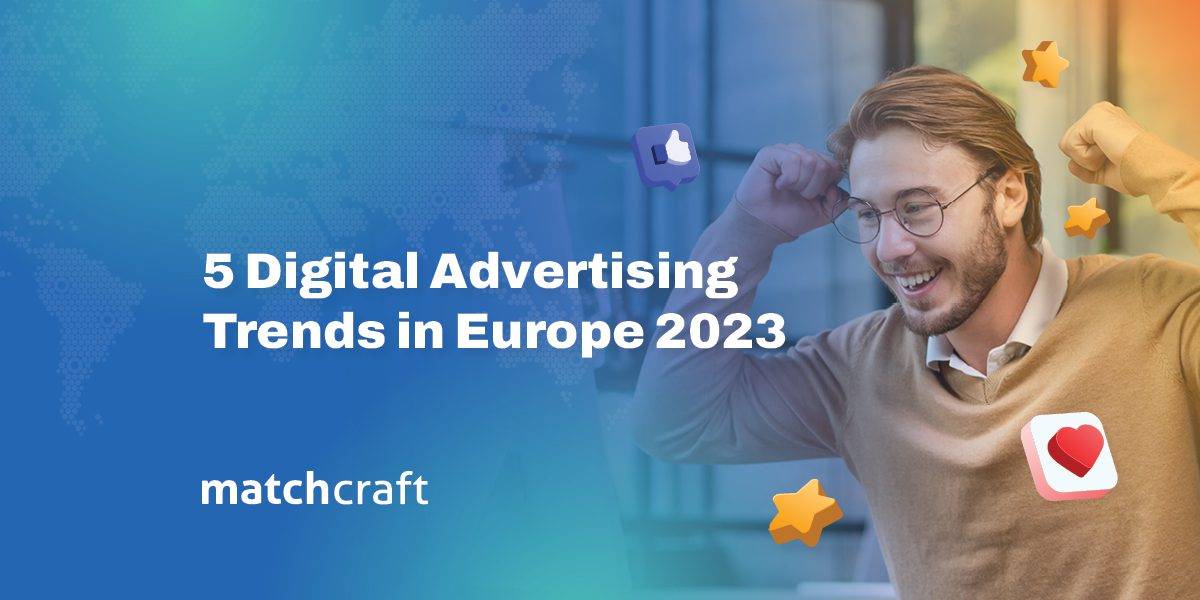The current economic climate in Europe has presented many challenges for businesses, with inflation rates rising and the impact of the Russia-Ukraine war and other political and commercial issues affecting households and companies alike. With a possible recession on the horizon, many firms are facing a decrease in consumer spending, leaving them fighting for a share of the market.
In this challenging economic climate, digital advertising is set to become an increasingly important area for businesses looking to stand out and reach buyers. In this blog post, we will discuss some of the top digital advertising trends in Europe that every ad agency and reseller must know in 2023.
Search Advertising
In 2023, there will be a partial shift away from display ads and renewed emphasis on search advertising. Search spending is expected to increase at a faster rate than total digital ad spending, with Western Europe predicted to see a 9.2% rise in search spending in 2023 compared to an 8.9% increase in overall digital ad spending according to eMarketer forecast.
Meanwhile, spending on retail media networks is rapidly increasing with expected outlays of €25 billion by 2026. This shift towards retail media is reflected in the increasing number of advertisers and agencies already using retailer media platforms. Brands that use retail media wisely can benefit from better ad placements, digital promotions, and tapping into retailer loyalty programs and validated sales data.
Still– search engines remain the first port of call for many consumers when searching for goods or services. Brands must refine their search advertising strategies and tactics.
Social Media Advertising
Europe’s social media audience continues to grow, making social platforms a crucial element in most advertisers’ strategies for 2023. However, Facebook’s user base in the region is projected to decrease, with just 8.7% of global users in 2023 according to eMarketer. While Facebook is losing market share, Instagram, Snapchat, TikTok, and Twitter are gaining popularity, with Western Europe predicted to have a double-digit share of the global total for each of these platforms.
Despite Twitter’s increasing popularity, advertisers and users are concerned about the platform’s future due to frequent technical malfunctions and uncertainty regarding content moderation and general operations. Similarly, a ban on Facebook in Russia resulted in a significant decline in usage. Advertisers should proceed with caution on these platforms until there is more clarity about their future direction.
Video Advertising
Video advertising is another growing trend in Europe. With the popularity of video content on platforms like YouTube and Tiktok, advertisers are finding new ways to reach their audience through video ads. Online video ad spend to rise from US$95 billion in 2024.
Nearly 40% of all display spend in Europe goes toward the online video market. It is also the fastest-growing segment of social media. Digital media buyers, on average, are investing 36% of total ad spend in video advertising, excluding TV formats. The most frequently purchased video advertising is mobile web, with a quarter of media buyers investing over 61% of their digital budget in this channel.
Programmatic Advertising
Programmatic advertising is becoming increasingly popular in Europe. Programmatic advertising involves the use of algorithms to buy and place digital advertisements. This technology enables advertisers to purchase ad space in real time, making the process more efficient and cost-effective. With programmatic advertising, advertisers can target specific audiences and optimize campaigns based on performance data.
In Europe, the Connected TV (CTV) market has seen a significant surge in recent years, with more consumers shifting away from traditional linear TV options and opting for online streaming. Voice, which was previously non-existent as a growth area, also made a strong appearance. In 2021, CTV advertising spend increased in Europe by over 56%, with a predicted 35% growth in 2022. This trend is expected to continue, as eMarketer forecasts that over-the-top (OTT) subscribers in Western Europe will increase from 133 million in 2019 to 159 million by 2023. This suggests that CTV will continue to be one of the key programmatic growth areas over the next 12 months, driven by the increased adoption of smart TVs and streaming devices, offering more opportunities for advertisers to reach their target audience.
First-Party Data and AI
The implementation of the General Data Protection Regulation (GDPR) in May 2018 has had a significant impact on the European advertising ecosystem. Advertisers and publishers are progressively shifting away from third-party cookies, a change that not only addresses consumer privacy concerns but also fosters trust in brands that prioritize their users’ preferences. This trend is expected to continue in 2023, with advertisers focusing on placing ads based on the context of the content a user is consuming, rather than relying solely on user data.
With the reduced availability of third-party data for ad targeting, businesses are expected to continue investing in first-party data collection and Customer Data Platforms. These platforms help companies consolidate, manage, and utilize their data to develop more precise and effective marketing strategies. Moreover, we can expect an increased collaboration between publishers and advertisers to navigate the complex regulatory landscape.
For larger enterprises, the growing trend towards personalized experiences is prompting them to invest in AI and reevaluate their business operations. However, European organizations exhibit a slower adaptation to AI utilization compared to their global counterparts, with only 23% embracing AI in Europe, as opposed to 33% in the Asia Pacific region and 29% in North America.
What the 2023 Europe Trends mean to Resellers and Advertisers
In conclusion, the digital advertising landscape in Europe for 2023 is set to be characterized by a continued emphasis on user privacy, innovative advertising strategies, and an evolving regulatory framework. It is also critical that resellers offer multi-channel campaigns to their advertisers. This can help increase the reseller’s value proposition and attract more advertisers.
